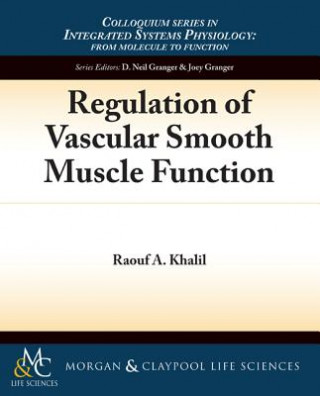
Code: 04839002
Regulation of Vascular Smooth Muscle Function
by Raouf Khalil
Vascular smooth muscle (VSM) constitutes most of the tunica media in blood vessels and plays an important role in the control of vascular tone. Ca2+ is a major regulator of VSM contraction and is strictly regulated by an intricate ... more
- Language:
 English
English - Binding: Paperback
- Number of pages: 62
Publisher: Morgan & Claypool Publishers, 2010
- More about this

You might also like
-

Dune
34.84 zł -33 % -

Haunting Adeline
125.81 zł -1 % -

Berserk Deluxe Volume 2
212.65 zł -1 % -

White Nights
15.40 zł -23 % -

Powerless
48.75 zł -11 % -

Atomic Habits
59.22 zł -26 % -

Dune Messiah
46.33 zł -3 % -

Berserk Deluxe Volume 3
218.19 zł -3 % -

One Day
32.63 zł -36 % -

Berserk Deluxe Volume 1
211.84 zł -2 % -

Iron Flame
61.14 zł -28 % -

Surrounded by Idiots
36.76 zł -28 % -

Harry Potter and the Prisoner of Azkaban (Minalima Edition)
170.44 zł -2 % -

Gravity Falls Journal 3
89.45 zł -

Heaven Official's Blessing: Tian Guan Ci Fu (Novel) Vol. 1
88.94 zł -1 % -

The Creative Act
100.22 zł -15 % -

Dune
47.34 zł -23 % -

Hunting Adeline
126.52 zł -4 % -

A Little Life
47.04 zł -14 % -

Children of Dune
46.73 zł -2 % -

Heaven Official's Blessing: Tian Guan Ci Fu (Novel) Vol. 2
77.76 zł -14 %
Give this book as a present today
- Order book and choose Gift Order.
- We will send you book gift voucher at once. You can give it out to anyone.
- Book will be send to donee, nothing more to care about.
More about Regulation of Vascular Smooth Muscle Function
You get 93 loyalty points
 Book synopsis
Book synopsis
Vascular smooth muscle (VSM) constitutes most of the tunica media in blood vessels and plays an important role in the control of vascular tone. Ca2+ is a major regulator of VSM contraction and is strictly regulated by an intricate system of Ca2+ mobilization and Ca2+ homeostatic mechanisms. The interaction of a physiological agonist with its plasma membrane receptor stimulates the hydrolysis of membrane phospholipids and increases the generation of inositol 1,4,5-trisphosphate (IP3) and diacylglycerol (DAG). IP3 stimulates Ca2+ release from the intracellular stores in the sarcoplasmic reticulum. Agonists also stimulate Ca2+ influx from the extracellular space via voltage-gated, receptor-operated, and store-operated channels. Ca2+ homeostatic mechanisms tend to decrease the intracellular free Ca2+ concentration ([Ca2+]i) by activating Ca2+ extrusion via the plasmalemmal Ca2+ pump and the Na+/Ca2+ exchanger and the uptake of excess Ca2+ by the sarcoplasmic reticulum and possibly the mitochondria. A threshold increase in [Ca2+]i activates Ca2+-dependent myosin light chain (MLC) phosphorylation, stimulates actin-myosin interaction, and initiates VSM contraction. The agonist-induced maintained increase in DAG also activates specific protein kinase C (PKC) isoforms, which in turn cause phosphorylation of cytoplasmic substrates that increase the contractile myofilaments force sensitivity to Ca2+ and thereby enhance VSM contraction. Agonists could also activate Rho kinase (ROCK), leading to inhibition of MLC phosphatase and further enhancement of the myofilaments force sensitivity to Ca2+. The combined increases in [Ca2+]i, PKC and ROCK activity cause significant vasoconstriction and could also stimulate VSM hypertrophy and hyperplasia. The protracted and progressive activation of these processes could lead to pathological vascular remodeling and vascular disease.
 Book details
Book details
Book category Books in English Medicine Pre-clinical medicine: basic sciences Physiology
159.26 zł
- Full title: Regulation of Vascular Smooth Muscle Function
- Author: Raouf Khalil
- Language:
 English
English - Binding: Paperback
- Number of pages: 62
- EAN: 9781615041800
- ISBN: 161504180X
- ID: 04839002
- Publisher: Morgan & Claypool Publishers
- Weight: 164 g
- Dimensions: 237 × 191 × 5 mm
- Date of publishing: 01. May 2010
safisfied customers
Since 2008, we have served long line of book lovers, but each of them was always on the first place.
Copyright! ©2008-24 libristo.pl All rights reservedPrivacyPoučení o cookies



 21 million books
21 million books Delivery 12.99 zł
Delivery 12.99 zł (32) 444 93 66 (8-15.30h)
(32) 444 93 66 (8-15.30h)